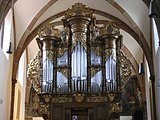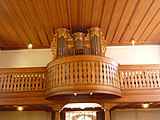Johann Ignaz Seuffert
Johann Ignaz Seuffert (born August 1, 1728 in Würzburg , † February 4, 1807 in Kirrweiler (Palatinate) ) was a German organ builder .
life and work
Johann Ignaz Seuffert was the eldest son of the famous Würzburg organ builder Johann Philipp Seuffert and his wife Anna Magdalena geb. Hillenbrand. He learned organ building in Lorraine and initially worked in Nancy with Nicolas Dupont . He then moved to Offenburg , where he became a citizen in 1759, and worked with his student Johann Ferdinand Balthasar Stieffell . In 1767 he moved to Rastatt . While his younger brother Franz Ignaz Seuffert took over his father's business in Würzburg in 1768 , Johann Ignaz Seuffert parted ways with Stieffel in the same year and opened a workshop in Kirrweiler in the Upper Palatinate as the “Princely Speyer Country Organ Maker”.
The organs of the Seuffert brothers are very similar in appearance and sound concept. Later Johann Ignaz Seuffert adapts to the Upper Rhine-French style and no longer builds pointed towers. Characteristic of his design is closely mensurierte Register Piffara , a Schwebesalizional , which he introduced with step-coat from 1750 in Baden.
The Palatinate line of the Seuffert organ building family was continued by his son Franz Seuffert (born January 17, 1773 in Kirrweiler, † August 20, 1855 ibid) and then by his grandson Johann Franz Seuffert (born September 4, 1814 in Kirrweiler, † 1886 ibid). Numerous new organs were built here by around 1850. Due to the supra-regional competition in organ building and the shift of civil interest to piano building, the Kirrweiler workshop only carried out repairs and maintenance work.
Works (selection)
Around 30 new organs by Johann Ignaz Seuffert have been documented, some of which have been preserved (in a modified form).
The size of the instruments is indicated in the fifth column by the number of manuals and the number of sounding registers in the sixth column. A capital “P” stands for a separate pedal. Italicization indicates that the organ in question is no longer available or that only the brochure is from the workshop.
| year | place | building | image | Manuals | register | Remarks |
|---|---|---|---|---|---|---|
| 1754 | Bad Langenbrücken | St. Vitus |

|
I / P | 14th | The new building by Karl Göckel (1992) integrates the few preserved Seuffert registers and the prospectus. |
| 1755 | Ettlingen | St. Martin | II / P | 15th | not received | |
| 1760 | Neckarau | St. James | I / P | 11 | Sold in 1887 to the Marienkirche (Lauda) , where the prospectus has been preserved. | |
| 1762 | Offenburg | Holy Cross Church | I / P | Rückpositiv supplemented by Stieffell in 1784; Housing received | ||
| 1764 | Alsheim | Assumption Day | I / P | 14th | Restored in 2018 by Orgelbau Vleugels | |
| 1765 | Rastatt | Rastatt Castle , Castle Church | I / P | 12 | together with Ferdinand Stieffell; receive | |
| 1771 | Frankenthal | Trinity Church | II / P | 16 | not received | |
| 1771 | Eppstein | St. Cyriac | I / P | 11 | Sold to Einselthum at the end of the 19th century , back in Eppstein since 1997; largely preserved | |
| 1771 | Upper High City | St. George | not received | |||
| 1772 | Landau in the Palatinate | Collegiate church |

|
I / P | 19th | Prospectus received |
| 1779-1780 | Worms-Abenheim | St. Boniface | I / P | 17th | burned around 1900 | |
| 1780 | Königsbach on the Wine Route | St. John Baptist and Sebastian | not received | |||
| 1782 | Heiligenstein | St. Sigismund | I / P | 14th | Renewed in 1812 after war damage by Franz Seuffert, preserved several times rearranged | |
| 1782 | Freimersheim | Ev. church | not received | |||
| 1784 | amounts | Ev. church | I / P | 13 | originally presumably built for Ulm (Renchen) and moved to Mengen in 1880. | |
| 1786 | Mörlheim | Catholic Church | I / P | 10 | largely preserved | |
| 1785 | Durmersheim | Maria Bickesheim | not received | |||
| 1788 | Rheinsheim | St. Vitus |

|
I / P | 14th | Sold to Mechtersheim in 1893, the facade of the Neustadt collegiate church has been preserved since 1968 |
| 1792 | Dahn | St. Laurence | I / P | 17th | in the 19th century a backwork was added; Replaced in 1928 | |
| 18th century | Insheim | Ev. church |

|
I / P | 13 | receive |
literature
- Bernhard H. Bonkhoff: Monument organs in the Palatinate (= 132nd publication of the Society of Organ Friends ). Evangelischer Presseverlag Pfalz, Speyer 1990, ISBN 3-925536-27-2 .
- Roland Eberlein : Organ register. Their names and their history . 3. Edition. Siebenquart, Cologne 2016, ISBN 978-3-941224-00-1 .
- Hermann Fischer , Theodor Wohnhaas : Lexicon of southern German organ builders . Florian Noetzel Verlag, Wilhelmshaven 1994, ISBN 3-7959-0598-2 , p. 385-387 .
- Hermann Fischer: The organ builder Johann Philipp Seuffert and his descendants in Würzburg, Kirrweiler and Vienna . Commission publisher Ferdinand Schöningh, Würzburg 2015, ISBN 978-3-87717-077-9 , p. 83-90 .
- Rudolf Walter: The organ building style by Joh. Philipp Seuffert (1693–1780). In: Acta Organologica . Vol. 20, Kassel 1988, pp. 113-148.
Web links
- Literature by and about Johann Ignaz Seuffert in the catalog of the German National Library
- Hermann Fischer: Seuffert organ builder . In: German biography . Vol. 24, 2010, pp. 278-279.
Individual evidence
- ^ Fischer, Wohnhaas: Lexicon of south German organ builders. 1994, p. 386.
- ^ A b Hermann Fischer : Seuffert organ builder . In: German biography . Vol. 24, 2010, pp. 278-279.
- ↑ Eberlein: Organ register. 2016, p. 465.
- ^ Fischer: The organ builder Johann Philipp Seuffert and his descendants. 2015, pp. 88–90.
- ^ Organ in Bad Langenbrücken , accessed on November 19, 2019.
- ^ Organ in Eppstein , accessed on November 19, 2019.
- ↑ Eberlein: Organ register. 2016, p. 269.
- ^ Franz Bösken: Sources and research on the organ history of the Middle Rhine (= contributions to the Middle Rhine music history . Volume 6 ). tape 1 : Mainz and suburbs - Rheinhessen - Worms and suburbs . Schott, Mainz 1967, ISBN 3-7957-1306-4 , p. 233-234 .
- ↑ Bonkhoff: historic organs in the Palatinate. 1990, p. 100.
- ^ Organ in Quantities , accessed on November 19, 2019.
- ↑ Bonkhoff: historic organs in the Palatinate. 1990, p. 112.
| personal data | |
|---|---|
| SURNAME | Seuffert, Johann Ignaz |
| ALTERNATIVE NAMES | Seuffert, Johannes Ignatius |
| BRIEF DESCRIPTION | German organ builder |
| DATE OF BIRTH | August 1, 1728 |
| PLACE OF BIRTH | Wurzburg |
| DATE OF DEATH | February 4, 1807 |
| Place of death | Kirrweiler (Palatinate) |

